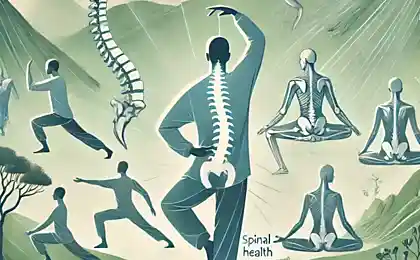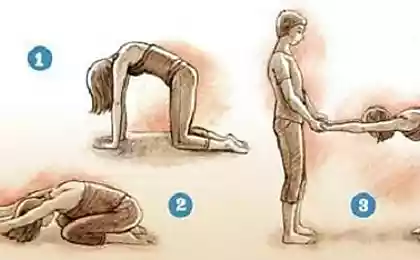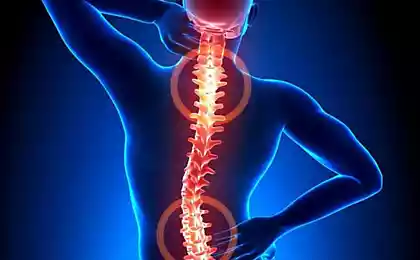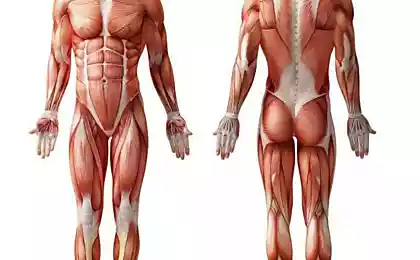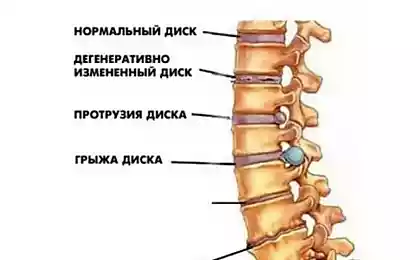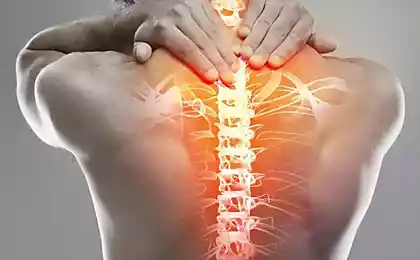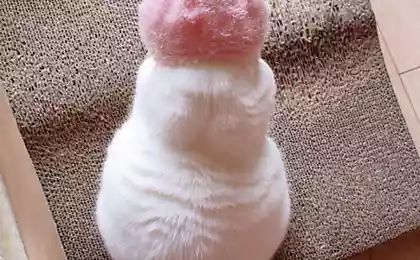637
5 exercises to restore the spine by Bragg
The following set of exercises for the spine designed by Paul Bragg. It consists of five basic exercises. They have a different effect on a particular division of the vertebral column. You need to perform them all within one training session. Between exercises take a break.
Starting to exercise for the spine should be guided by the following rules:
1) do not apply sharp force to the lost mobility of parts of the spine;
2) do the exercises, commensurate with their load, starting with low and gradually increasing it;
3) do not try to exercise with a maximum amplitude of – start with small movements, oscillating the vertebrae to gently and gradually increasing their amplitude.
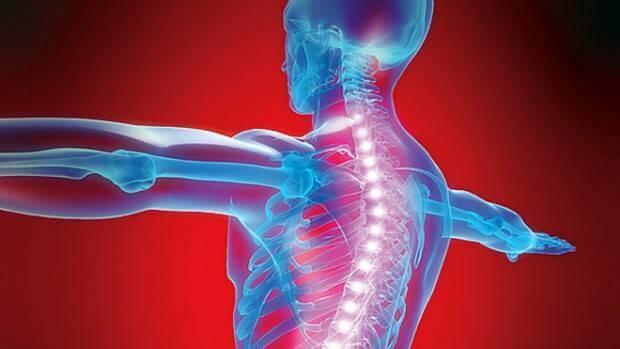
EXERCISE 1.
Affects the upper part of the spine. There are nerves controlling the head muscles of the eyes, the stomach and intestines. This exercise facilitates the elimination of ailments such as headache, eye strain, indigestion, and poor digestion.
Starting position: lie on the floor face down. In the lying position, place your palm under the breast and spread the legs shoulder-width apart. Then gradually adopt the following provision: relying only on palms and toes, lift your upper body up and lignite the back arc. The pelvis should be positioned above the head. Head down and arms and legs fully extended.
Once you have accepted the position, gently take the following: drop the pelvis almost to the floor. The arms and legs should be straight. This provision gives a special tension to the spine. Now raise your head and take her back.
To perform this exercise slowly and smoothly. Try to lower the pelvis as low as possible, and then raise it as high as possible, arching up the back. Exercise is that you lower and raise the pelvis, arching and rotting spine. These movements contribute to its stretching and setting of the vertebrae into place.
The number of repetitions in the beginning 2-4 times. As fitness increases to 8-12 times.
EXERCISE 2.
This exercise is intended mainly to spinal Department, from which originate the nerves that control the functioning of the liver, gall bladder and kidneys. This exercise brings relief in case of disorders and diseases. The result of this exercise the weakened liver, gallbladder, kidneys and bladder will significantly improve their work.
Take the starting position is the same as in exercise 1. Once you have raised the pelvis and arched his back, perform the following: rotate the pelvis more to the left, lowering the left side as low as possible, and then to the right the same movement. Hands and feet during the exercise do not bend. Movement to be done slowly, smoothly, mentally imagining that the spine is stretched with each turn getting better and better. A combination of stretching of the spine with some twist helps to ensure that the vertebrae of the better "sit" in its place.
Initially, the exercise will seem quite difficult and tedious. Limit yourself to 2-4 iterations. Gradually doing it will be easier strengthening not only muscles, but also spinal nerves.
Then increase the number of executions up to 8-12 times.
EXERCISE 3.
The previous two exercises have given quite a lot of stress on the muscles and ligaments of the spine. Exercise number three is meant to remove residual stress and to completely relax the spine. The result is stimulated every nerve center. Additionally easier as the pelvic area.
One important feature of this exercise is the ability to strengthen the muscles of the spine, which maintain it in a stretched condition and thereby contribute to the restoration of the intervertebral discs.
Starting position: sit on the floor, rest on the placed direct arms, located just behind, legs bent. Raise your pelvis so that your body relied only on spaced bent legs and straight arms. Exercise should be done at a fast pace that helps to relax the spine. To raise the body to a horizontal position of the spine, after which it is lowered to its original position.
Repeat the exercise 6-8 times at the beginning and 12-18 times at the end.
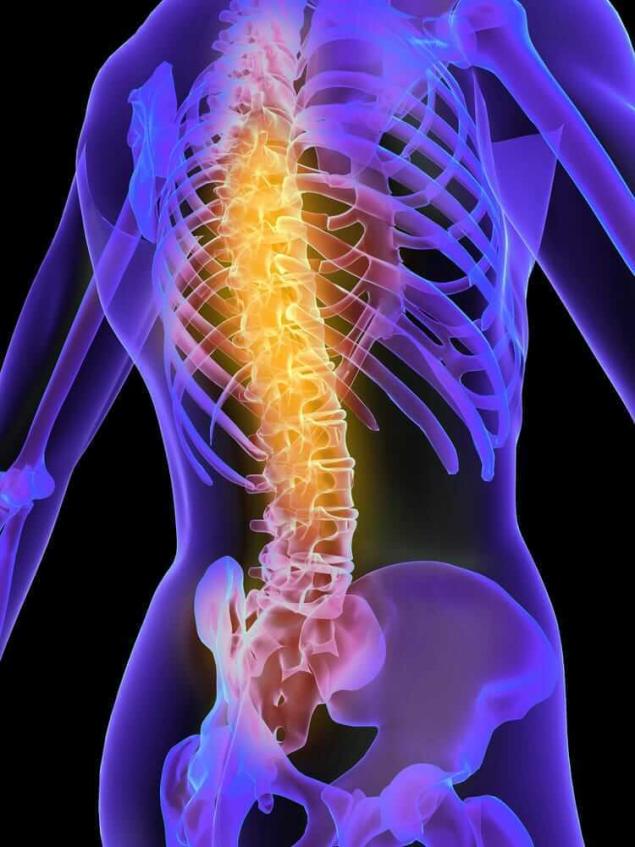
EXERCISE 4.
This exercise is designed to give a special force of that part of the spine, from which come the nerves that control the stomach. In General, it is effective for the whole of the spine, contributes to its tension. It is the stretching of the spine, releasing strangulated nerve roots of the spinal cord, leads the entire body in a normal, functional, healthy state.
Starting position: lie on your back, legs extended, arms at sides. Bend your knees, pull them to your chest and clasp your hands. Make a movement as if you wish to push the knees and thighs from the breast, but continue to hold their hands. Simultaneously with this movement, lift your head and try to touch the chin to the knees. Keep this position of the body in 3-5 seconds.
In this exercise, there is a sharp push, which stretches the spine, thereby removing the lock on a small infringements, impaction between the vertebrae.
Additionally, this exercise allows you to strengthen not only abdominal muscles, but deep muscles located on the ventral portion of the spinal column.
Repeat the exercise 2-4 times.
EXERCISE 5.
Walking on all fours. This exercise Paul Bragg considered one of the most important for stretching of the spine. Among other things it involves the spine, from which extend the nerves that control the working of the colon.
Starting position as for exercise 1. Take a standing position on all fours: hands and legs are straight, back is arched by the arc, the pelvis raised high, head down. In this position, it is recommended to bypass the indoor room. Remember: during the movement of the legs and arms do not bend and "go" on the straight limbs. During such movement the load on the spine is minimal and there is some twisting of the spine. It is this movement contributes to a better stretching of the spine and setting his disc into place.
Also interesting: How to recognize the syndromes of the spine osteochodrosis
Exercises developing thin muscle fibers of the spine
Describes a set of exercises P. Bragg advises to perform based on their individual characteristics. It is recommended to perform each exercise no more than 2-3 times. The next day the number of repetitions can be increased up to five times more.
The frequency of classes, the first Bragg recommends exercise every day. After the spine appeared to need improvement, you can reduce the number of classes to two times a week. This is enough to keep the spine flexible and stretched.
You should know that pathological changes in the spine has occurred over many years and not just one day to make it healthy and young. Please be patience and perseverance. Constant training of the spine will stimulate the recovery and growth of the intervertebral discs, which will make the spine stretched, flexible and healthy.published
Source: vk.com/wall-23903469?offset=4280&w=wall-23903469_744%2Fall
Starting to exercise for the spine should be guided by the following rules:
1) do not apply sharp force to the lost mobility of parts of the spine;
2) do the exercises, commensurate with their load, starting with low and gradually increasing it;
3) do not try to exercise with a maximum amplitude of – start with small movements, oscillating the vertebrae to gently and gradually increasing their amplitude.

EXERCISE 1.
Affects the upper part of the spine. There are nerves controlling the head muscles of the eyes, the stomach and intestines. This exercise facilitates the elimination of ailments such as headache, eye strain, indigestion, and poor digestion.
Starting position: lie on the floor face down. In the lying position, place your palm under the breast and spread the legs shoulder-width apart. Then gradually adopt the following provision: relying only on palms and toes, lift your upper body up and lignite the back arc. The pelvis should be positioned above the head. Head down and arms and legs fully extended.
Once you have accepted the position, gently take the following: drop the pelvis almost to the floor. The arms and legs should be straight. This provision gives a special tension to the spine. Now raise your head and take her back.
To perform this exercise slowly and smoothly. Try to lower the pelvis as low as possible, and then raise it as high as possible, arching up the back. Exercise is that you lower and raise the pelvis, arching and rotting spine. These movements contribute to its stretching and setting of the vertebrae into place.
The number of repetitions in the beginning 2-4 times. As fitness increases to 8-12 times.
EXERCISE 2.
This exercise is intended mainly to spinal Department, from which originate the nerves that control the functioning of the liver, gall bladder and kidneys. This exercise brings relief in case of disorders and diseases. The result of this exercise the weakened liver, gallbladder, kidneys and bladder will significantly improve their work.
Take the starting position is the same as in exercise 1. Once you have raised the pelvis and arched his back, perform the following: rotate the pelvis more to the left, lowering the left side as low as possible, and then to the right the same movement. Hands and feet during the exercise do not bend. Movement to be done slowly, smoothly, mentally imagining that the spine is stretched with each turn getting better and better. A combination of stretching of the spine with some twist helps to ensure that the vertebrae of the better "sit" in its place.
Initially, the exercise will seem quite difficult and tedious. Limit yourself to 2-4 iterations. Gradually doing it will be easier strengthening not only muscles, but also spinal nerves.
Then increase the number of executions up to 8-12 times.
EXERCISE 3.
The previous two exercises have given quite a lot of stress on the muscles and ligaments of the spine. Exercise number three is meant to remove residual stress and to completely relax the spine. The result is stimulated every nerve center. Additionally easier as the pelvic area.
One important feature of this exercise is the ability to strengthen the muscles of the spine, which maintain it in a stretched condition and thereby contribute to the restoration of the intervertebral discs.
Starting position: sit on the floor, rest on the placed direct arms, located just behind, legs bent. Raise your pelvis so that your body relied only on spaced bent legs and straight arms. Exercise should be done at a fast pace that helps to relax the spine. To raise the body to a horizontal position of the spine, after which it is lowered to its original position.
Repeat the exercise 6-8 times at the beginning and 12-18 times at the end.

EXERCISE 4.
This exercise is designed to give a special force of that part of the spine, from which come the nerves that control the stomach. In General, it is effective for the whole of the spine, contributes to its tension. It is the stretching of the spine, releasing strangulated nerve roots of the spinal cord, leads the entire body in a normal, functional, healthy state.
Starting position: lie on your back, legs extended, arms at sides. Bend your knees, pull them to your chest and clasp your hands. Make a movement as if you wish to push the knees and thighs from the breast, but continue to hold their hands. Simultaneously with this movement, lift your head and try to touch the chin to the knees. Keep this position of the body in 3-5 seconds.
In this exercise, there is a sharp push, which stretches the spine, thereby removing the lock on a small infringements, impaction between the vertebrae.
Additionally, this exercise allows you to strengthen not only abdominal muscles, but deep muscles located on the ventral portion of the spinal column.
Repeat the exercise 2-4 times.
EXERCISE 5.
Walking on all fours. This exercise Paul Bragg considered one of the most important for stretching of the spine. Among other things it involves the spine, from which extend the nerves that control the working of the colon.
Starting position as for exercise 1. Take a standing position on all fours: hands and legs are straight, back is arched by the arc, the pelvis raised high, head down. In this position, it is recommended to bypass the indoor room. Remember: during the movement of the legs and arms do not bend and "go" on the straight limbs. During such movement the load on the spine is minimal and there is some twisting of the spine. It is this movement contributes to a better stretching of the spine and setting his disc into place.
Also interesting: How to recognize the syndromes of the spine osteochodrosis
Exercises developing thin muscle fibers of the spine
Describes a set of exercises P. Bragg advises to perform based on their individual characteristics. It is recommended to perform each exercise no more than 2-3 times. The next day the number of repetitions can be increased up to five times more.
The frequency of classes, the first Bragg recommends exercise every day. After the spine appeared to need improvement, you can reduce the number of classes to two times a week. This is enough to keep the spine flexible and stretched.
You should know that pathological changes in the spine has occurred over many years and not just one day to make it healthy and young. Please be patience and perseverance. Constant training of the spine will stimulate the recovery and growth of the intervertebral discs, which will make the spine stretched, flexible and healthy.published
Source: vk.com/wall-23903469?offset=4280&w=wall-23903469_744%2Fall
This is a natural product — the secret of the beautiful skin of Indian women
Varieties of water purification systems for country houses

